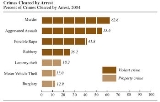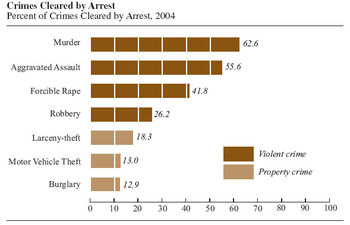
Clearance rate
Encyclopedia

Criminal justice
Criminal Justice is the system of practices and institutions of governments directed at upholding social control, deterring and mitigating crime, or sanctioning those who violate laws with criminal penalties and rehabilitation efforts...
, clearance rate is calculated by dividing the number of crimes that are "cleared" (a charge being laid) by the total number of crimes recorded. Clearance rates are used by various groups as a measure of crime
Crime
Crime is the breach of rules or laws for which some governing authority can ultimately prescribe a conviction...
s solved by the police.
Clearance rates can be problematic for measuring the performance of police services and for comparing various police services. This is because a police force may employ a different way of measuring clearance rates. For example, each police force may have a different method of recording when a "crime" has occurred and different criteria for determining when a crime has been "cleared." One police force may appear to have a much better clearance rate because of its calculation methodology.
In System Conflict Theory
Conflict model (criminal justice)
The conflict model of criminal justice , sometimes called the non-system perspective or system conflict theory, argues that the organizations of a criminal justice system either do, or should, work competitively to produce justice, as opposed to cooperatively.-History:System conflict theory argues...
, it is argued that clearance rates cause the police to focus on appearing to solve crimes (generating high clearance rate scores) rather than actually solving crimes. Further focus on clearance rates may result in effort being expended to attribute crimes (correctly or incorrectly) to a criminal, which may not result in retribution, compensation, rehabilitation or deterrence.

